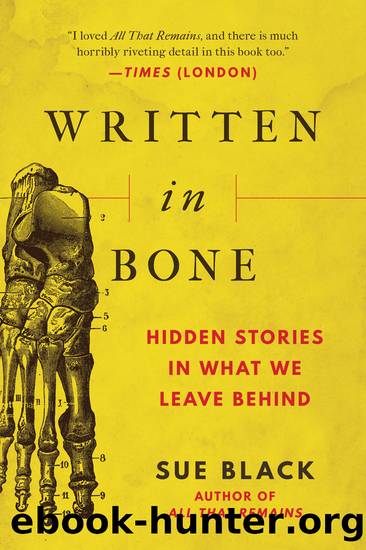Written in Bone by Sue Black

Author:Sue Black
Language: eng
Format: epub
ISBN: 9781951627942
Publisher: Arcade
Published: 2021-05-13T00:00:00+00:00
PART III
THE LIMBS
Postcranial Appendicular Bones
6
The Pectoral Girdle
âShoulder blades are where your wings were when you were an angelâ
David Almond
Writer
There are two âgirdlesâ in the human body. The word âgirdleâ is more commonly associated with womenâs corsetry, but I gave up using such analogies with my students when references to my motherâs Playtex girdle and Cross-Your-Heart bra drew nothing but blank looks. Evidently I was showing my age.
Our upper bony girdle is the pectoral or shoulder girdle, which connects the bones of the arm (humeri) to the trunk and comprises paired clavicles (the collar bones) at the front and scapulae (shoulder blades) at the back. The lower one, the pelvic girdle, consists of the two hip bones, which form a junction between the sacrum at the back and the femora (thigh bones) of the lower limbs at the sides.
It is interesting that the pectoral girdle should contain both the bone that is the least likely, of all the bones in the body, to fractureâthe scapulaâand the one most prone to being broken: the clavicle. While all primates possess a collar bone, it is rudimentary in many mammals and absent altogether in the ungulates, which include a variety of animals from horses to pigs, and even the hippopotamus. Cats, for example, have very rudimentary clavicles, which is why they can squeeze through spaces that appear to be much too narrow to accommodate them.
In humans, the clavicle, as well as being a convenient location for muscle attachment, serves as a strut to keep our arms out to the sides of our body. In most quadrupedal animals, the forelimbs, positioned underneath the body, are used solely for locomotion, and as no dual function for the clavicle is required it does not need to be very large. Yet amazingly, the human clavicle isnât really essential. We can have it taken out as long as the muscles can be stitched to each other. In the past, some jockeys used to have their clavicles surgically removed as a preventative measure. Since it was the bone most often broken in falls from their horses, there was a school of thought that maintained it was better to do without it than to risk the perils of a fracture.
And there is no question that a broken clavicle can be life-threatening. The bone is shaped like an elongated âSâ and a fracture will occur at the weakest point, the major bend in the lateral third. Unfortunately, that lies directly over the subclavian artery and vein, which are very large, and makes them susceptible to being ruptured or pierced by sharp shards of broken bone.
Sir Robert Peel, who served twice as Britainâs prime minister between 1834 and 1846 and is regarded as the father of modern policing (hence the antiquated nickname âpeeler,â and the more enduring âbobby,â for a police officer), met his end as a result of a fractured collar bone. He had acquired a new horse, a hunter, which had a bit of a reputation as a kicker. Sir Robert
Download
This site does not store any files on its server. We only index and link to content provided by other sites. Please contact the content providers to delete copyright contents if any and email us, we'll remove relevant links or contents immediately.
The Girls I've Been by Tess Sharpe(1209)
Firekeeper's Daughter by Angeline Boulley(1134)
21st Birthday (Women's Murder Club) by James Patterson(1104)
I Think I Love You by Auriane Desombre(1059)
Harry Potter and the Sorcerer's Stone by Rowling J K(1057)
Harry Potter 01 - Harry Potter and the Sorcerer's Stone by J.K. Rowling(1022)
Let's Talk About Hard Things by Anna Sale(938)
The Lion King by Disney Book Group(925)
Perfect Illusion by Claudia Tan(906)
Flamefall by Rosaria Munda(848)
You Are Awesome by Neil Pasricha(795)
The Montessori Baby by Simone Davies(779)
You'd Be Home Now by Kathleen Glasgow(727)
Time To Go by Time To Go (epub)(700)
A Pho Love Story by Loan Le(693)
Pax, Journey Home by Sara Pennypacker(659)
Aristotle and Dante Discover the Secrets of the Universe by Sáenz Benjamin Alire(634)
Yolk by Mary H. K. Choi(623)
Sandwiches! by Alison Deering(610)
